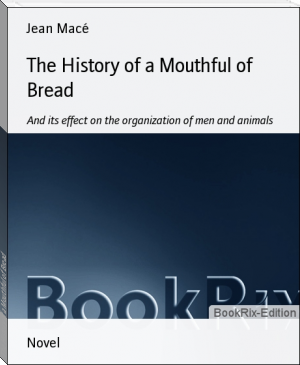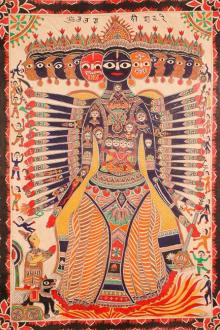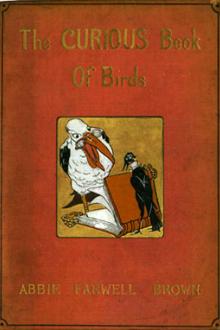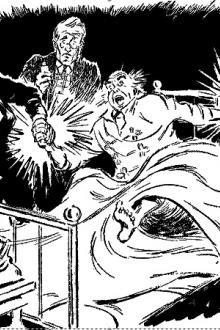The History of a Mouthful of Bread, Jean Macé [best autobiographies to read TXT] 📗

- Author: Jean Macé
Book online «The History of a Mouthful of Bread, Jean Macé [best autobiographies to read TXT] 📗». Author Jean Macé
herself here. Not satisfied with two systems in one animal, she appears to have got hold of three.
If we continue the examination of this privileged reptile, we shall find many other infractions of the usual rules of his class. His tongue, certainly, is fastened to his mouth like that of the tortoise, so much so that the ancient Egyptians told the Greeks he had not got one; but his set of teeth clearly approach those of the lower mammals. You have probably heard a great deal of the strength of the crocodile's formidable teeth. Travellers have given them this reputation; but we have nothing to do with that now. They stand in battle array, in a single line, along the whole length of the jaws, into which they are sunk with genuine fangs, whilst the prongs of our little lizard are merely fastened to the surface of the bones which support them. Indeed, in one way, the crocodile is even better provided than the mammals. He possesses under each tooth one or two germs, the life of which lasts as long as that of the animal, and which are always there ready toreplace the previous one should it chance to fall out. There are many ladies, and (not to be rude) gentlemen as well, who would, I am sure, give a great deal to have as many teeth at their service. Indeed, they may possibly think Dame Nature very unjust to have selected this great villanous beast rather than us as the object of a gift which they would have been so well able to appreciate. But we must not blame nature too quickly: she had her reasons. We, during our infancy, have teeth in reserve. Now, a reptile may be considered as an imperfect rough draft of a mammal; and the crocodile gives one thoroughly the idea of a mammal half-finished and fixed for life in a state of childhood. I am sorry that I cannot enter into full details, that you might see how far the idea is a just one. Moreover, in his character of a perpetual child, he is always growing bigger all his life long, and never seems able to die but by accident, hardly ever, I may really say, from old age. By specimens kept in captivity, it has been ascertained that their growth is very slow. Well, imagine their being only from seven to eight inches long when they come out of the shell, and that full-grown crocodiles have been found thirty feet in length, and calculate accordingly. You will not account for it under a century; and I should like to know what would become of this venerable child of more than a hundred years old if kind Mother Nature had not left him our system of milk-teeth to the end?
A curious peculiarity of these persistent teeth is, that they are hollow inside, so much so, that the bowls of tobacco-pipes are said to be made from them in Europe. I mention the fact, although of no great interest to you, for the benefit of any pipe-merchants who have not yet thought of sending for such things to Cairo.
But let us return to the efforts perceptible in the organization of the crocodile to raise itself to a higher level. The soft palate, as we called it (Letter VII.), is wanting in other reptiles; but here there is one which completely closes the entrance of the windpipe (the larynx). I announced, too, the disappearance of the diaphragm; and we bewailed together the loss of that servant of the good old times, whose touching history you must, I am sure, remember. But I reckoned without this wretched crocodile, who seems determined to give the lie to all we have been saying. He has a diaphragm, and one which acts well enough in the main, although it is pierced right through the middle, as if it were rather ashamed of being there, and wished to make up for dividing the body into two compartments, against all proper reptile regulations, by opening a door of communication between them. What shall I tell you besides? The lungs, not to be behind the rest of this aristocratic reptile's organization, are hollowed into cells much more complicated than those of his fellows. You find here no end of nooks and corners, which multiply opportunities of contact between the air and the blood, and so give the crocodile almost the respiration of the mammals, as he has already got pretty nearly their system of circulation.
With serpents, again, we fall very low. When we were speaking of the tortoises I told you that, in proportion as we come down in the scale, the digestive tube has a tendency to get rid of its accessories, and to assume the appearance of a perfectly straight tube. If any one were to cut open a serpent before you, you would see this final condition almost reached already. In the first place, the soft palate is entirely suppressed, and the mouth extends straight into the oesophagus, whose tube seems to run through the whole length of the body without interruption, with just four or five doublings towards the base, in that part which represents the intestines. An imperceptible swelling indicates the place where the real stomach lies within; but in another sense one may call the oesophagus, and I might almost add the mouth itself, its stomach. You shall see how.
The jaws of serpents are even in a more unfinished state than those of other reptiles. Nature has not taken the time to weld the different parts of them together; but these begin by not being very firmly joined, remember, in young mammals. The bones of the head, which support the jaws, are themselves movable, and can be detached from the skull if necessary, so as to allow the throat to open extraordinarily wide; thus it is not uncommon to see a serpent swallow animals much larger than itself. You will be horrified when I tell you that the anaconda, one of the giants of the family, swallows large quadrupeds at a single mouthful. What are our mouthfuls in comparison with his? however, it must be confessed, that his often take several days to go down. When the animal has rolled up his prey in his terrible folds, he pounds and kneads it till it is reduced to a kind of long roll, which he moistens with a copious slaver to make it slip down more easily. Then, attacking it at one end, he fastens this very expansive jaw upon it, and the gigantic mouthful slowly begins its journey; what was left outside the mouth, advancing little by little, in proportion as the digestion reduces what has entered to pulp, and sends it farther down. This is on great occasions; but in the case of more modest prey-a rabbit, for instance-the mouthful goes in whole at one gulp and remains stationary, partly in the oesophagus, partly in the stomach, while the powerful juices distilled by the walls of the latter are dissolving it.
You can see that a soft palate would have been quite useless here, and that the serpent has not much need of teeth to chew his food. Accordingly, his are nothing but simple prongs, like those of the lizard, and, like his, they extend over the palate, the more effectually to cut off the return of the swallowed masses of food. About a hundred and twenty have been counted in the throat of the boa-constrictor; but their number varies considerably in the different species. They are not organs of the highest order, and nature is not very particular about the quantity.
There is only one tooth among serpents of which she takes any particular care, and that is the venomous tooth which she has bestowed on certain species, and which serves them for striking down, as it were, the animals on which they feed. Let us study it in the rattlesnake, the most celebrated of this odious race. On each side of the upper jaw you may see, isolated from the others, and exceeding them all in length, a very sharp fang pierced through by a tiny canal, which opens into a gland placed at the root of the tooth. The bone which supports this little apparatus is very flexible, and when at rest, the fang, falling back, hides itself in a fold of the gum. When the animal wishes to bite, it springs up again, and the gland, compressed by the action of biting, sends into the little canal a jet of poison, which runs through it into the wound. As far as can be ascertained, this poison paralyses the victim and disorders the blood, which at once loses its power, and no longer acts upon the organs as before; still it is only injurious when it has been carried by the current of circulation into the mass of the blood; if swallowed, it has no effect whatever on the stomach. Now do not look at me with such incredulous eyes, as if it were quite impossible any one should think of swallowing such a thing. You have no idea what a scientific man is capable of when he comes to close quarters with nature, for the purpose of extracting one of her secrets. He has his own fields of battle, where very often as much courage is displayed as on any other.
These two fangs, in which lie all the power of the animal, are of the greatest importance to him, and their want of solidity makes them liable to remain in the wounds which they have made. In consequence of this, they enjoy the same privilege as the teeth of the crocodile, and in a still greater degree even. Behind each poison fang lie in wait, not one nor two, but several sentinel germs, ready at the first alarm of a loss to set to work and re-supply the disarmed serpent with his venomous needle. So the serpent also lives in a state of perpetual childhood: he is always growing; and I could not tell you the exact natural limits of his life any more than of that of the crocodile. They are gentlemen who do not allow themselves to be very closely studied in a state of freedom. But these also grow very slowly, and some have been met with whose size had extended quite enormously from their first start. I ought to tell you, once for all, that this indefinite growth, joined to extreme longevity, is found in many of the inferior species whom we have yet to consider. It seems the portion of these unfinished creatures, in which nature has only as it were sketched in her work, and who seem vowed to endless youth, in testimony of the state of childhood they represent, a state transitory among the superior animals, but permanent with them. It belonged of right, therefore, to the serpent, which is the most unfinished animal we have yet met with, and who, at the first glance, seems almost reduced to a mere digestive tube, lodged between a vertebral column and a series of small ribs, whose number sometimes reaches three hundred. The liver, which, with us, presents such a distinct and bulky mass, is here elongated into a thin cord, which runs the whole length of the oesophagus and intestine, to the walls of which it is, to some extent, attached.
It is the same with the lungs. There is rarely room for the full development of two in this narrow conduit, where everything has to follow the shape of the master of the house: one, therefore, is often merely indicated by a very slight protuberance; the other, presenting the appearance of a long tube, which extends nearly half-way down the body, and whose feeble action halts periodically at each of those monstrous repasts, after which the torpid
If we continue the examination of this privileged reptile, we shall find many other infractions of the usual rules of his class. His tongue, certainly, is fastened to his mouth like that of the tortoise, so much so that the ancient Egyptians told the Greeks he had not got one; but his set of teeth clearly approach those of the lower mammals. You have probably heard a great deal of the strength of the crocodile's formidable teeth. Travellers have given them this reputation; but we have nothing to do with that now. They stand in battle array, in a single line, along the whole length of the jaws, into which they are sunk with genuine fangs, whilst the prongs of our little lizard are merely fastened to the surface of the bones which support them. Indeed, in one way, the crocodile is even better provided than the mammals. He possesses under each tooth one or two germs, the life of which lasts as long as that of the animal, and which are always there ready toreplace the previous one should it chance to fall out. There are many ladies, and (not to be rude) gentlemen as well, who would, I am sure, give a great deal to have as many teeth at their service. Indeed, they may possibly think Dame Nature very unjust to have selected this great villanous beast rather than us as the object of a gift which they would have been so well able to appreciate. But we must not blame nature too quickly: she had her reasons. We, during our infancy, have teeth in reserve. Now, a reptile may be considered as an imperfect rough draft of a mammal; and the crocodile gives one thoroughly the idea of a mammal half-finished and fixed for life in a state of childhood. I am sorry that I cannot enter into full details, that you might see how far the idea is a just one. Moreover, in his character of a perpetual child, he is always growing bigger all his life long, and never seems able to die but by accident, hardly ever, I may really say, from old age. By specimens kept in captivity, it has been ascertained that their growth is very slow. Well, imagine their being only from seven to eight inches long when they come out of the shell, and that full-grown crocodiles have been found thirty feet in length, and calculate accordingly. You will not account for it under a century; and I should like to know what would become of this venerable child of more than a hundred years old if kind Mother Nature had not left him our system of milk-teeth to the end?
A curious peculiarity of these persistent teeth is, that they are hollow inside, so much so, that the bowls of tobacco-pipes are said to be made from them in Europe. I mention the fact, although of no great interest to you, for the benefit of any pipe-merchants who have not yet thought of sending for such things to Cairo.
But let us return to the efforts perceptible in the organization of the crocodile to raise itself to a higher level. The soft palate, as we called it (Letter VII.), is wanting in other reptiles; but here there is one which completely closes the entrance of the windpipe (the larynx). I announced, too, the disappearance of the diaphragm; and we bewailed together the loss of that servant of the good old times, whose touching history you must, I am sure, remember. But I reckoned without this wretched crocodile, who seems determined to give the lie to all we have been saying. He has a diaphragm, and one which acts well enough in the main, although it is pierced right through the middle, as if it were rather ashamed of being there, and wished to make up for dividing the body into two compartments, against all proper reptile regulations, by opening a door of communication between them. What shall I tell you besides? The lungs, not to be behind the rest of this aristocratic reptile's organization, are hollowed into cells much more complicated than those of his fellows. You find here no end of nooks and corners, which multiply opportunities of contact between the air and the blood, and so give the crocodile almost the respiration of the mammals, as he has already got pretty nearly their system of circulation.
With serpents, again, we fall very low. When we were speaking of the tortoises I told you that, in proportion as we come down in the scale, the digestive tube has a tendency to get rid of its accessories, and to assume the appearance of a perfectly straight tube. If any one were to cut open a serpent before you, you would see this final condition almost reached already. In the first place, the soft palate is entirely suppressed, and the mouth extends straight into the oesophagus, whose tube seems to run through the whole length of the body without interruption, with just four or five doublings towards the base, in that part which represents the intestines. An imperceptible swelling indicates the place where the real stomach lies within; but in another sense one may call the oesophagus, and I might almost add the mouth itself, its stomach. You shall see how.
The jaws of serpents are even in a more unfinished state than those of other reptiles. Nature has not taken the time to weld the different parts of them together; but these begin by not being very firmly joined, remember, in young mammals. The bones of the head, which support the jaws, are themselves movable, and can be detached from the skull if necessary, so as to allow the throat to open extraordinarily wide; thus it is not uncommon to see a serpent swallow animals much larger than itself. You will be horrified when I tell you that the anaconda, one of the giants of the family, swallows large quadrupeds at a single mouthful. What are our mouthfuls in comparison with his? however, it must be confessed, that his often take several days to go down. When the animal has rolled up his prey in his terrible folds, he pounds and kneads it till it is reduced to a kind of long roll, which he moistens with a copious slaver to make it slip down more easily. Then, attacking it at one end, he fastens this very expansive jaw upon it, and the gigantic mouthful slowly begins its journey; what was left outside the mouth, advancing little by little, in proportion as the digestion reduces what has entered to pulp, and sends it farther down. This is on great occasions; but in the case of more modest prey-a rabbit, for instance-the mouthful goes in whole at one gulp and remains stationary, partly in the oesophagus, partly in the stomach, while the powerful juices distilled by the walls of the latter are dissolving it.
You can see that a soft palate would have been quite useless here, and that the serpent has not much need of teeth to chew his food. Accordingly, his are nothing but simple prongs, like those of the lizard, and, like his, they extend over the palate, the more effectually to cut off the return of the swallowed masses of food. About a hundred and twenty have been counted in the throat of the boa-constrictor; but their number varies considerably in the different species. They are not organs of the highest order, and nature is not very particular about the quantity.
There is only one tooth among serpents of which she takes any particular care, and that is the venomous tooth which she has bestowed on certain species, and which serves them for striking down, as it were, the animals on which they feed. Let us study it in the rattlesnake, the most celebrated of this odious race. On each side of the upper jaw you may see, isolated from the others, and exceeding them all in length, a very sharp fang pierced through by a tiny canal, which opens into a gland placed at the root of the tooth. The bone which supports this little apparatus is very flexible, and when at rest, the fang, falling back, hides itself in a fold of the gum. When the animal wishes to bite, it springs up again, and the gland, compressed by the action of biting, sends into the little canal a jet of poison, which runs through it into the wound. As far as can be ascertained, this poison paralyses the victim and disorders the blood, which at once loses its power, and no longer acts upon the organs as before; still it is only injurious when it has been carried by the current of circulation into the mass of the blood; if swallowed, it has no effect whatever on the stomach. Now do not look at me with such incredulous eyes, as if it were quite impossible any one should think of swallowing such a thing. You have no idea what a scientific man is capable of when he comes to close quarters with nature, for the purpose of extracting one of her secrets. He has his own fields of battle, where very often as much courage is displayed as on any other.
These two fangs, in which lie all the power of the animal, are of the greatest importance to him, and their want of solidity makes them liable to remain in the wounds which they have made. In consequence of this, they enjoy the same privilege as the teeth of the crocodile, and in a still greater degree even. Behind each poison fang lie in wait, not one nor two, but several sentinel germs, ready at the first alarm of a loss to set to work and re-supply the disarmed serpent with his venomous needle. So the serpent also lives in a state of perpetual childhood: he is always growing; and I could not tell you the exact natural limits of his life any more than of that of the crocodile. They are gentlemen who do not allow themselves to be very closely studied in a state of freedom. But these also grow very slowly, and some have been met with whose size had extended quite enormously from their first start. I ought to tell you, once for all, that this indefinite growth, joined to extreme longevity, is found in many of the inferior species whom we have yet to consider. It seems the portion of these unfinished creatures, in which nature has only as it were sketched in her work, and who seem vowed to endless youth, in testimony of the state of childhood they represent, a state transitory among the superior animals, but permanent with them. It belonged of right, therefore, to the serpent, which is the most unfinished animal we have yet met with, and who, at the first glance, seems almost reduced to a mere digestive tube, lodged between a vertebral column and a series of small ribs, whose number sometimes reaches three hundred. The liver, which, with us, presents such a distinct and bulky mass, is here elongated into a thin cord, which runs the whole length of the oesophagus and intestine, to the walls of which it is, to some extent, attached.
It is the same with the lungs. There is rarely room for the full development of two in this narrow conduit, where everything has to follow the shape of the master of the house: one, therefore, is often merely indicated by a very slight protuberance; the other, presenting the appearance of a long tube, which extends nearly half-way down the body, and whose feeble action halts periodically at each of those monstrous repasts, after which the torpid
Free e-book «The History of a Mouthful of Bread, Jean Macé [best autobiographies to read TXT] 📗» - read online now
Similar e-books:





Comments (0)